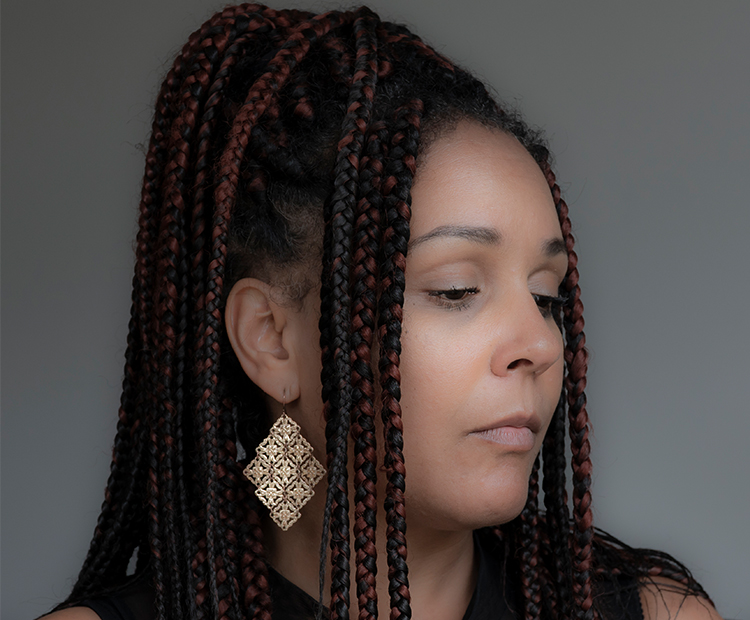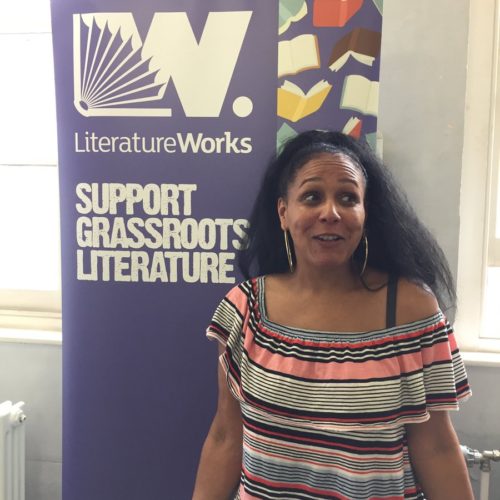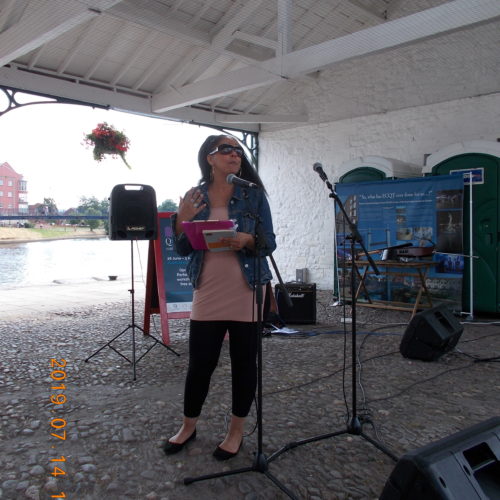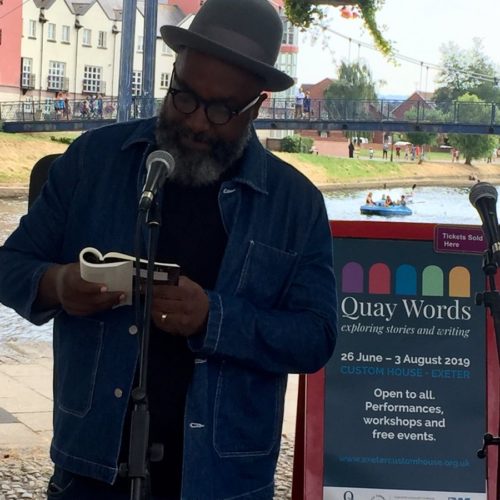For six weeks in the summer of 2019, Louisa Adjoa Parker was our first Quay Words writer-in-residence. Read her blog post reflecting on the residency.
When I heard that I was going to be the first ever writer-in-residence at the Custom House, Exeter, as part of the Quay Words 2019 programme, I was really excited. Partly because prior to this I hadn’t had any residencies in Exeter – a city which I have many connections with, and love – and also because it meant I had the opportunity to combine two things I’m passionate about: history and literature. I enjoyed my time at the Custom House even more than I could have imagined, and I was sorry when the residency came to an end.
Some places quickly begin to feel like home. The Custom House was one of these, and this became my routine: arriving once or twice a week, after walking down the cobbled street, through tall blue doors with their heavy iron knocker, up the grand staircase, gazing up at the animals and plaster plants growing from the ceilings. Putting my bags down under ‘my’ large mahogany desk, next to a fireplace still caked with soot. Listening to the sounds drifting in from outside: seagulls, people cycling past, the echo of hammers on rooftops making me think of the clang of metal on metal that would have echoed around the quayside during its industrial era. I loved spending time in this old redbrick building, where paint peels from the walls, where the ancient stone floor and straw in barrels transports you back to the past.
During the residency I carried out historical research about the Custom House and the quayside, which I intended to draw on to produce a creative writing piece. I held weekly drop-in sessions and chatted to local people about the site, writing, and local history. I delivered a writing workshop with Newtown Primary School, and held a one-to-one mentoring session with a talented local writer.
I began my research by talking to staff at the Customs House, the Literature Works team, and local people. I also researched online – the Exeter Memories site is a fantastic resource. I was looking to uncover little known stories of the building and surrounding area, and I was particularly interested in stories relating to people and communities that have not traditionally been represented in history.
I was lucky enough to meet the last person to lock the door when the building was a Custom House, Roger Luscombe. He talked to me about working as a Customs and Excise Officer and described the Long Room, which was open to the public, how the rest of the building was used as offices, and downstairs was where goods were unloaded and assessed. I’ve used some of what Roger described in my final written piece.
Roger also told me:
I came to Exeter in the 1960s. Customs and Excise officers lived everywhere, we’d go around to gain experience. It radiated out from here. I’d worked here twenty years, full-time the last eight. The quay was still working then, mid 1960s. The last timber boat came in. There were bonded warehouses across the road. We stored wines and spirits free of tax, until they were sent out the door.
I quickly realised there were limits to how much I could learn during a six-day residency. I did, however, gain a sense of the rich layers of history surrounding the site; a glimpse into the lives of some of the people who passed through, lived, worked and died there.
I learned that in contrast to today, with its cafes, shops and bars selling expensive goods, the area around the quayside was once one of the poorest parts of the city, a slum where infant mortality rates were high, offal, rotting vegetables, and animal dung was piled high in the streets, and Cholera – amongst other illness – took many lives. I learned that for many years the area was the centre of woollen cloth production; women drove carts and collected urine from local inns and households, and this was used in one of many stages of cloth preparation. The fields were filled with racks, where cloth hung on tenterhooks dried in the sun. I can imagine that the smell coming from this can’t have been too pleasant!
There were links with global history and the Transatlantic slave trade – sugar, in different forms, arrived at the quayside and was processed nearby. Local families such as the Kennaways, Buttalls and Barings were involved in the trade and owned (or had connections with) slave plantations in the Caribbean. I haven’t so far discovered evidence of any enslaved Africans brought back by local people to live in the area, although it’s likely that some were.
And there were stories about women, such as Eleanor Coade, a successful manufacturer and businesswoman. In Georgian times, industry was dominated by men, yet Eleanor ran a business which made both architectural and garden ornaments, made from a type of artificial and extremely hard-wearing stone she created. Eleanor died unmarried, and left money to some of her married female friends, so that their husbands would have no control over their money.
Sue Palmer responded to my request for local stories in the Exeter Memories Facebook group, and told me about the life of her paternal grandfather, Alfie Carpenter: My grandfather Alfie was born in the West Quarter in 1900. He was a sickly new-born, and wasn’t expected to survive so was christened immediately. He thrived, however, and grew into a tall, immensely strong man. I remember him from the 1950s – he lived with my grandmother Laura and their children in Bowhay Lane, St Thomas.
He would rise very early (3.00 or 4.00 am) and ride his carrier bike (like an old butcher’s bike) down to the quay to buy fish from the boats that came up from Exmouth. He would get some ice, pack up the fish then cycle back to the house. There, in the kitchen he would gut, clean and fillet the fish and pack it in ice again. He would also eat an enormous breakfast, cooked by Laura. All this before he left the house again, certainly before 8.00 am, often earlier.
He took a different route each day, calling on houses and village shops and cycling many miles, to places such as Haldon, Dunsford, Christow and Chudleigh. Many households depended on their weekly delivery of fish from him. He kept going on whatever he was offered, often farm-made cider. In later years the boats dwindled, and he got fish from wholesalers, but still from the quay. He became ill in the late 1950s, and stopped working by 1960. He died in 1962. He has many descendants in Exeter.
As well as my own writing and research, the residency enabled me to take part in the fantastic Quay Words programme. I was invited to support Roger Robinson, who performed dub poetry in the Transit Shed on a Sunday afternoon. Roger was promoting his latest collection, A Portable Paradise. I was blown away by Roger’s beautiful, heartfelt poems, set to music. It was a surreal experience hearing stories about Grenfell, Windrush and chicken shops, and hearing race and identity explored in a space – and region – where these topics are not often discussed. I bought Roger’s book – it’s a stunning collection.
I also attended a session with Sam North, and gained positive feedback and useful ideas on how to shape the novel I’ve been working on (for some time). On my last day at the Custom House I stayed on to see Patrick Gale talking about his latest novel, Take Nothing With You, which was a brilliant event. I’ve seen Roger and Patrick perform before, and they are both fantastic performers, highly talented writers, and warm and friendly people too.
I am very grateful to have had this opportunity, and am grateful to all the Literature Works team, and the staff at the Custom House for all their help and support. I am sure the Customs House will go from strength to strength, and flourish as a centre for literature in Exeter.



